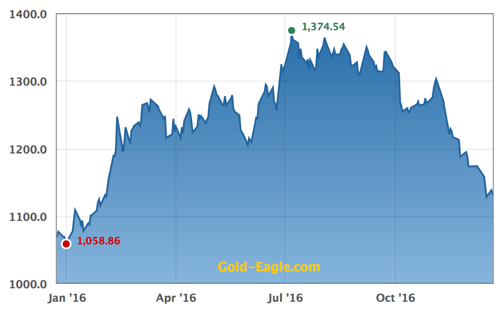Gold Price Forecast: Searching For Predictive Markers In 2017
By now, gold’s performance in 2016 is largely in the books. We know that gold is up on the year after starting in the mid-1,000’s. Consequently, if it were to close today, the price of gold would be up about 6%. In the world of commodities, that’s a strong year, even if it’s been tempered by recent pessimism for the yellow metal.
Where will gold be at the end of 2017? Using some of the most important markers in gold from 2016, we can only guess. But in 2017, we can make that an educated guess. Let’s examine what really affected the price of gold in 2016:
Where Was Gold In 2016?

Looking back on it, there were essentially two big spikes in the price of gold throughout 2016: in late February and early March, and once again after the now-infamous Brexit vote over the summer.
But what caused that spike in February and March—a spike that lasted for months with gold never finding a new bottom until later in the year?
There were a few elements here:
- “Risk aversion is back,” Oaktree Chairman Howard Marks was quoted as saying. At the time, demand for precious metals thanks to low bond yields and lack of interest rates in savings meant that anyone with aversions toward the stock market was looking at precious metals as a store of wealth.
- Demand was high. As stated in the previous point, the lack of options for savers and risk-averse wealth managers meant that gold was the most efficient source of savings in some cases. If you wanted money stored efficiently but didn’t want it in the stock market, gold was the place to be. Strong consumer demand for the precious metal didn’t hurt, either.
There was no signature “Brexit”-like event in early 2016, no singular move into gold to identify. But as the charts show, growth was sharp. We’ll want to be on the lookout for similar problems in savings and interest rates in the future if we’re going to forecast the price of gold.
Political Upheaval: Expect More In 2017?
Gold is a hedge against stocks and against instability in general. After the Presidential election in 2016—which coincides with a sharp decline in the price of gold, as you might notice, more optimism swept through the economy, capping off with a rise in the Federal Reserve’s interest rate goals.
All indications for 2017 thus far are that the Fed will seek to raise interest rates even higher. Political upheaval is by definition difficult to predict, which is why so many investors keep a portion of their investments in gold to begin with.
Making Sense Of The Future
Forecasting the price of anything is difficult, even over long-term trends like an entire year. But if 2017 is a similar year to 2016—and we’re not suggesting it will be—then it could suggest moderate growth for gold even in the face of increased economic optimism. With the Dow Jones Index breaking records, there are some contrarians who believe this might be a great time to buy gold. Only the New Year can tell.

















